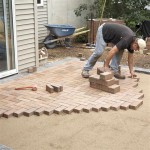How to Do a Concrete Patio DIY: Ideas and Steps
A concrete patio is a durable and versatile addition to any outdoor space. It provides a solid foundation for furniture, grilling, and relaxing, and can complement various landscape designs. With some planning and effort, you can build a concrete patio yourself, saving money and gaining a sense of accomplishment. This guide explains the steps involved in building a concrete patio, along with DIY ideas to personalize your space.
1. Planning and Preparation
Before starting any construction project, careful planning is crucial. This includes determining the size, shape, and location of your patio. Consider factors like:
- Available space: Measure the area to be covered and ensure there is adequate space for your desired patio size.
- Existing structures: Account for existing structures like houses, fences, and trees, and plan the patio’s layout accordingly.
- Access and drainage: Ensure easy access to the area and proper drainage to prevent water buildup.
- Purpose and design: Determine the intended use of the patio – for dining, lounging, or entertaining – and choose a design that complements your existing landscaping.
- Materials: Research different types of concrete and determine the best option for your needs, considering durability, aesthetics, and budget.
Once you have a clear plan, prepare the area:
- Clear the area: Remove any vegetation, debris, or existing structures within the proposed patio area.
- Level the ground: Use a shovel or rake to create a level surface. This ensures the concrete will pour evenly. You may need to add or remove soil to achieve the desired level.
- Mark the perimeter: Use stakes and string to mark the outline of your patio. Ensure the lines are straight and parallel.
- Dig trenches: If you are creating a patio with a border or a raised edge, dig trenches along the perimeter and compact the soil thoroughly.
2. Building the Forms
Forms are essential for creating the desired shape and size of your patio. They act as molds to contain the concrete while it sets. Choose durable materials like plywood or treated lumber for the forms.
To build the forms:
- Cut the lumber: Measure and cut the lumber to fit the perimeter of your patio design. Ensure the cuts are precise for straight edges and corners.
- Assemble the forms: Use nails or screws to join the lumber sections, creating a sturdy frame. Ensure the form is level and plumb using a level and plumb bob.
- Install the forms: Secure the forms to the ground using stakes or concrete anchors. Ensure they are tightly fitted against the ground and against each other to prevent concrete from leaking.
- Add reinforcement: If you are creating a large or heavily used patio, consider adding reinforcing bars (rebar) to the concrete. This will increase its strength and prevent cracking.
3. Pouring the Concrete
Once the forms are in place, you can pour the concrete. It's crucial to order the right amount of concrete for your project. Be sure to consider the thickness of the patio.
To pour the concrete:
- Prepare the mixing area: Choose a flat, stable surface for mixing the concrete. Use a wheelbarrow or a large mixing tub for easy handling.
- Mix the concrete: Follow the manufacturer's instructions for mixing the concrete. Use a concrete mixer or a shovel to combine the cement, sand, gravel, and water thoroughly. Ensure a consistent mixture is achieved.
- Pour the concrete: Gradually pour the concrete into the forms, ensuring it fills the space evenly. Use a shovel or rake to spread the concrete and eliminate any air pockets.
- Level the concrete: Use a screed board to smooth and level the surface of the concrete. Move the screed board back and forth across the forms, removing excess concrete and ensuring a flat surface.
- Finish the surface: Once the concrete has been leveled, finish the surface using a broom, trowel, or other finishing tools. The desired finish will depend on your preferences, but a broom finish is common for patios.
4. Curing the Concrete
Curing is essential for the strength and durability of the concrete. It involves keeping the concrete moist for several days to allow it to harden properly.
To cure the concrete:
- Cover the concrete: Immediately after pouring, cover the concrete with a layer of plastic sheeting, burlap, or wet burlap sacks. This prevents the concrete from drying out too quickly.
- Keep the concrete moist: Mist the concrete surface with water regularly to maintain moisture levels. This can be done every few hours, especially during hot and dry weather.
- Allow for curing time: Follow the manufacturer's recommendations for curing time. Typically, it takes around 28 days for concrete to reach its full strength. Avoid placing heavy objects or furniture on the patio during this time.
5. Finishing Touches
Once the concrete has cured, you can add finishing touches to enhance the look and functionality of your patio.
Consider:
- Adding a sealant: Apply a sealant to protect the concrete from stains, weathering, and damage. This can be done after the concrete has fully cured.
- Installing a border or edging: Use pavers, bricks, or stones to create a border around the patio, adding a decorative touch.
- Adding lighting: Install outdoor lighting to illuminate the patio area and enhance its ambiance. Options include pathway lights, string lights, or lanterns.
- Planting flowers or shrubs: Add greenery around the patio by planting flowers or shrubs. This can create a welcoming and visually appealing space.
Remember:
- Safety first: Always wear appropriate personal protective equipment (PPE) while working with concrete, including safety glasses, gloves, and sturdy closed-toe shoes.
- Check local regulations: Be aware of any local building codes or permits required for construction projects.
- Plan for weather: Monitor weather forecasts and postpone the concrete pouring if rain or extreme temperatures are predicted.
- Seek professional help: If you are unsure about any aspect of the project, consult with a professional contractor for guidance or assistance.

Diy Concrete Patio In 8 Easy Steps How To Pour A Cement Slab

Resurfacing A Concrete Patio For Budget Diy Makeover Fab Everyday

Diy Concrete Patio In 8 Easy Steps How To Pour A Cement Slab

13 Great Diy Outdoor Patio Flooring Ideas On A Budget

How To Install A Diy Concrete Patio

Easy Concrete Patio Coverup Ideas The Garden Glove

How To Pour Concrete For A Diy Patio Next Modular
:max_bytes(150000):strip_icc()/af1be3_8a5120ffaa094d259ee0ed2280752caemv2-1dc1d13dfd464c70b058dd64fd7f53d8-fc3afd1699244cb7bb805231a66aec72.jpeg?strip=all)
30 Concrete Patio Ideas On A Budget

Resurfacing A Concrete Patio For Budget Diy Makeover

The Solution To Decorating Concrete Patios Porches








